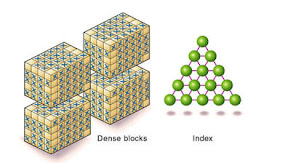In order to use MODEL, we would have to understand certain basics of how it can be used and in what situations it can be used. MODEL was introduced to generate sql queries that enables an end user to visualize the data in a multi-dimensional format. One can generate Multi MODEL references to do currency restatements etc. To understand this lets look at the BSO architecture diagram of Essbase. As you would probably know, BSO option consists of 2 parts
1. Sparse Dimensions that are stored as an index – So, these dimensions are typically stored in a normal relational row-wise format in Essbase.
2. Dense Dimensions that are stored as an Multi-Dimensional Array – These dimensions form a multi-dimensional array. The pointer to the array is denoted by the corresponding sparse dimension combination
2. Dense Dimensions that are stored as an Multi-Dimensional Array – These dimensions form a multi-dimensional array. The pointer to the array is denoted by the corresponding sparse dimension combination
In the same way, a MODEL clause consists of an index denoted by the Partition By Clause. The multidimensional array or a Block is denoted by the DIMENSION clause. The only difference between the 2 is the fact that you would have multiple measure blocks per partition by clause dimension combination. In the case of essbase, an index entry points to only one block. The reason for this is, MODEL clause does not treat the measure values as a seperate dimension. So, a MODEL clause treats a summarized sql query as shown below

No hay comentarios:
Publicar un comentario